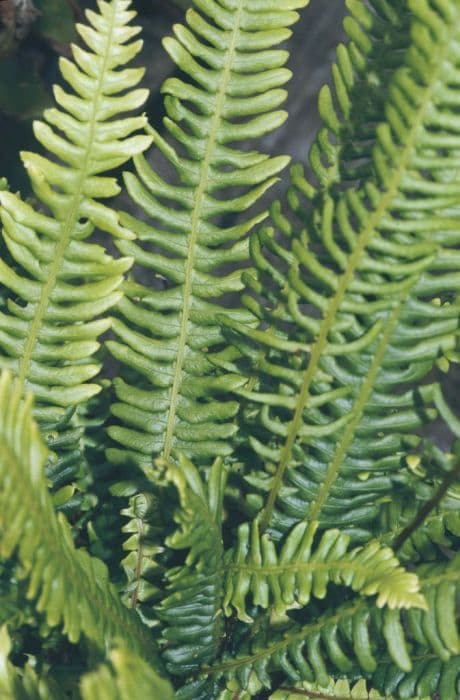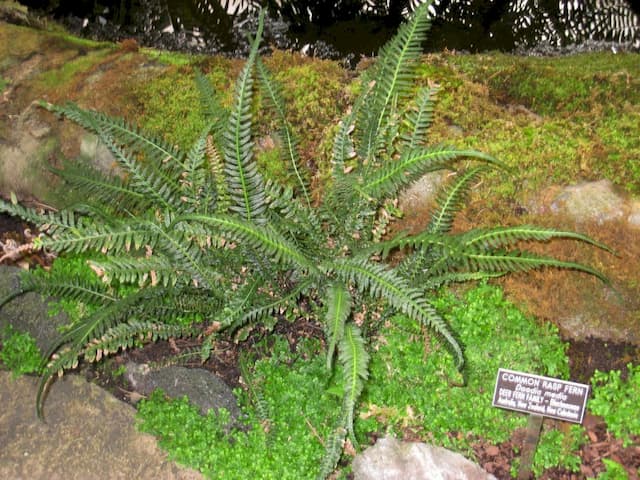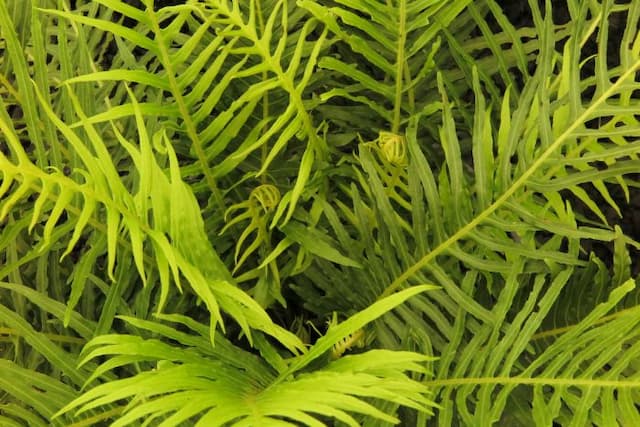Giant Chain Fern Woodwardia fimbriata






ABOUT
The common name for Woodwardia fimbriata is Giant Chain Fern. This plant is notable for its lush, green foliage that consists of long, arching fronds with a textured surface. The fronds emanate from a central point, creating a fountain-like spread. Each leaflet on the frond margin is finely-toothed, giving it a delicate and feathery look. The undersides of the fronds exhibit a unique chain-like pattern made by the arrangement of spores that appear as small brown dots. This distinguishing feature contributes to its common name, echoing a chain-like appearance. The overall impression of the Giant Chain Fern is one of a dense, bushy green plant with fronds that add a graceful texture to its surroundings, resembling cascading water in their flow and arrangement.
About this plant
 Names
NamesFamily
Blechnaceae
Synonyms
Giant Chain Fern, Western Chain Fern, Giant Chainfern
Common names
Aspidium fimbriatum, Lorinseria fimbriata, Nephrodium fimbriatum, Woodwardia radicans.
 Toxicity
ToxicityTo humans
Giant chain fern is not typically known for its toxicity to humans. There is no widespread documentation of poisoning or adverse effects from ingesting or contacting parts of this plant. However, it is generally advised that one should avoid consuming plants that are not known to be edible as they may cause unwanted reactions.
To pets
Giant chain fern is not commonly known to be toxic to pets. Pets that ingest parts of this plant are not typically expected to experience poisoning or severe adverse effects. Nevertheless, it is always best to be cautious and prevent pets from eating ornamental plants as they can sometimes cause mild digestive upset or other non-specific symptoms due to the plant material's irritant properties rather than toxicity.
 Characteristics
CharacteristicsLife cycle
Perennials
Foliage type
Evergreen
Color of leaves
Green
Height
4-6 feet (1.2-1.8 meters)
Spread
6-8 feet (1.8-2.4 meters)
Plant type
Fern
Hardiness zones
8
Native area
North America
Benefits
 General Benefits
General Benefits- Erosion Control: Woodwardia fimbriata, commonly known as Giant Chain Fern, has an extensive root system that helps stabilize soil and prevent erosion.
- Habitat Support: It provides habitat and food for wildlife, particularly for insects and other small animals.
- Aesthetic Appeal: With its large, arching fronds, the Giant Chain Fern can add natural beauty and visual interest to gardens and landscapes.
- Shade Tolerance: This fern can thrive in shaded areas, making it suitable for woodland gardens or other low-light environments.
- Low Maintenance: Once established, Woodwardia fimbriata requires minimal care, making it a convenient choice for gardeners.
- Drought Resistance: Although it prefers moist conditions, the Giant Chain Fern can tolerate periods of drought, increasing its versatility in various landscapes.
- Native Planting: As a native species, planting Woodwardia fimbriata helps preserve the local flora and contributes to biodiversity.
 Medical Properties
Medical PropertiesThis plant is not used for medical purposes.
 Air-purifying Qualities
Air-purifying QualitiesThis plant is not specifically known for air purifying qualities.
 Other Uses
Other Uses- Garden Ornamentation: The Giant Chain Fern is often used in landscaping for its decorative fronds, which add a lush, prehistoric aesthetic to gardens.
- Biomonitoring: Researchers can use the Giant Chain Fern to monitor the health of ecosystems, as its growth and condition reflect local environmental quality.
- Soil Erosion Control: Due to its spreading habit and substantial root system, the fern can be utilized to help prevent soil erosion on slopes and banks.
- Habitat Creation: The Giant Chain Fern can be used to create habitats for wildlife, offering cover and food resources for various species.
- Educational Tool: Botanical gardens and conservation programs may use the Giant Chain Fern to educate people about fern biology and the importance of native plant species.
- Humidity Regulation: By transpiring water, the fern can help maintain high humidity levels in greenhouses and indoor spaces.
- Symbolism and Art: Artists and designers might draw inspiration from the fern's intricate fronds, using them in patterns, photography, and botanical illustrations.
- Culinary Presentation: Although not edible, the fern's fronds might be used as a natural and decorative backing for presenting other foods.
- Natural Crafting: The fronds can be used in floral arrangements or to weave baskets and other natural crafts.
- Companion Planting: The Giant Chain Fern can be used in companion planting, providing ground cover and humidity that benefits other plants that thrive in similar environments.
Interesting Facts
 Feng Shui
Feng ShuiThe Giant Chain Fern is not used in Feng Shui practice.
 Zodiac Sign Compitability
Zodiac Sign CompitabilityThe Giant Chain Fern is not used in astrology practice.
 Plant Symbolism
Plant Symbolism- Growth: The Giant Chain Fern's robust size and expansive fronds symbolize personal growth and the ability to overcome obstacles.
- Resilience: As a hardy fern that can thrive in challenging environments, it represents resilience and adaptability.
- Eternity: Ferns are ancient plants that have existed for millions of years, thus the Giant Chain Fern can symbolize timelessness or eternity.
- Shelter: The large fronds of the Giant Chain Fern can provide shelter to smaller plants and animals, signifying protection and nurturing.
- Peace: The lush greenery and the serene feeling ferns often evoke can be associated with peace, tranquility, and a sense of calm.
 Water
WaterThe Giant Chain Fern should be watered thoroughly, ensuring that the soil is consistently moist but not waterlogged. In general, you should water the fern about once a week, but this can vary depending on the climate and the season; more frequent watering may be necessary during hot, dry periods and less during cooler, rainy seasons. When watering, aim to provide the Giant Chain Fern with approximately one to two gallons each time, adjusting for the size of the plant and the environmental conditions. Overhead watering will help mimic the fern's natural habitat, but make sure the water penetrates the soil to reach the roots.
 Light
LightThe Giant Chain Fern thrives in partial to full shade, which makes it an excellent choice for shady garden areas or north-facing windows if grown indoors. It should be protected from direct afternoon sun, as too much sunlight can scorch the delicate fronds. A spot that receives filtered light or dappled sunlight, like under a canopy of taller trees or shrubs, provides the ideal lighting conditions for this fern.
 Temperature
TemperatureThe Giant Chain Fern prefers temperatures between 60 and 70 degrees Fahrenheit for optimal growth. It can tolerate a minimum temperature of around 25 degrees Fahrenheit but should be protected from prolonged freezes. Ensure the fern is in a location where temperatures do not exceed 80 degrees Fahrenheit, as higher temperatures can stress the plant.
 Pruning
PruningPruning the Giant Chain Fern typically involves removing dead or damaged fronds to maintain the plant's health and appearance. This should be done as needed, usually once a year in late winter or early spring before new growth begins. Pruning at this time allows the fern to focus energy on producing new healthy fronds. When pruning, use clean, sharp shears, and cut the fronds close to the base without damaging the crown of the plant.
 Cleaning
CleaningAs needed
 Soil
SoilGiant Chain Fern prefers a rich, acidic to neutral soil mix with pH between 5.5 and 7.0. An ideal mixture would be one part peat, one part pine bark, and one part perlite or coarse sand to ensure proper drainage and aeration. Regular organic matter amendments can enhance soil fertility and structure, promoting healthy growth.
 Repotting
RepottingThe Giant Chain Fern should be repotted every 2-3 years or once it has outgrown its current pot. Springtime is ideal for repotting to allow the plant to establish in its new container during the growing season.
 Humidity & Misting
Humidity & MistingGiant Chain Fern thrives in high humidity conditions; ideally, the humidity level should be between 70-80%. Mist the plant regularly or use a humidifier to maintain these conditions, especially if the air in your home is dry.
 Suitable locations
Suitable locationsIndoor
Place Giant Chain Fern in bright, indirect light with high humidity.
Outdoor
Keep in partial shade with moist soil for best Giant Chain Fern growth.
Hardiness zone
7-9 USDA
 Life cycle
Life cycleGiant chain fern, Woodwardia fimbriata, begins its life cycle as a spore, which germinates under moist conditions to form a small, heart-shaped gametophyte. This gametophyte houses both male and female reproductive organs, which, upon maturity, produce sperm and eggs. Fertilization occurs when water allows the sperm to swim to the eggs, resulting in the development of a zygote. The zygote then grows into a young sporophyte, which is the familiar fern plant. As the sporophyte matures, it develops fronds and a rhizome, and, eventually, it produces sori—clusters of sporangia on the undersides of its fronds. Within these sporangia, spores are produced through meiosis, and when released, they start the life cycle anew.
 Propogation
PropogationPropogation time
Spring-Early Summer
The Giant Chain Fern, or Woodwardia fimbriata, is best propagated by spores which can be collected when they are ripe typically in the summer. To propagate by spores, one must first collect the spore-laden fronds as they turn brown and place them in a paper bag to dry. After a few days to a week, the spores will have fallen from the fronds and can be sown on the surface of a sterilized, moist potting mix comprised of peat and sand. This should be done in a warm environment with indirect light and a consistent temperature around 68°F (20°C). The container should be covered with plastic wrap or glass to maintain humidity, and in a few weeks to months, the spores will germinate into tiny prothalli, which will eventually develop into new fern plants.




